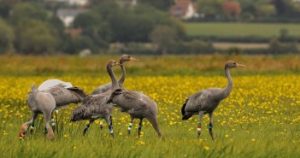By Dr Margherita Pieraccini, Lecturer in Law (University of Bristol Law School).*
 The EU plays a fundamental role in shaping the environmental law regimes of its Member States and that of the UK is no exception. A significant proportion of current domestic environmental law derives from EU Regulations (that automatically become part of English law) and EU Directives (that are implemented through national legislation).
The EU plays a fundamental role in shaping the environmental law regimes of its Member States and that of the UK is no exception. A significant proportion of current domestic environmental law derives from EU Regulations (that automatically become part of English law) and EU Directives (that are implemented through national legislation).
Nature conservation law, i.e. the legal regime used to protect environmentally significant habitats and species, is a case in point and the focus of this blog. Conserving nature is key not only from a purely biodiversity standpoint but also from an ‘ecosystem services’ perspective. Ecosystem services are the benefits nature brings to the environment and to people, including supporting services (e.g. nutrient cycling), provisioning services (e.g. food), regulating services (e.g. carbon capture) and cultural services (e.g. recreation).
Site designation and management is a favoured technique of nature conservation law. The well-known Natura 2000 network, would not be there if it were not for EU Directives, namely the Habitats (92/43/EEC) and Wild Birds Directives (2009/147/EC), implemented in the UK by the Conservation of Habitats and Species Regulations 2010. Under Article 3 of the Habitats Directive, Member States are indeed required to set up the Natura network composed of Special Areas of Conservation (sites hosting the natural habitat types listed in Annex I and habitats of the species listed in Annex II of the Habitats Directive) and Special Protection Areas (sites for the protection of rare and vulnerable birds as listed in Annex I of the Wild Birds Directive and for regularly occurring migratory species).
In the UK, there are a substantial number of European protected sites: 652 Special Areas of Conservation (including candidate Special Areas of Conservation[1] and Sites of Community Importance[2]) and 270 Special Protection Areas, covering a total of 8,013,467 ha (JNCC statistics as of 28 January 2016).
Has the establishment of Natura 2000 made a difference to biodiversity protection?
As part of its Smart Regulation Policy, the European Commission has initiated a fitness check of the Habitats and Wild Birds Directives to evaluate their effectiveness, efficiency, coherence, relevance and added value. Though the final Commission report on the results of the fitness check will be available only later this year, the draft emerging findings prepared by a consortium of experts do suggest that the Habitats and Wild Birds Directives have substantially contributed to the conservation of nature and to meeting the EU’s biodiversity target.
It is fair to note that, prior to the EU Directives on nature conservation, the UK did have its own system for habitat protection, most notably based on the designation of Sites of Special Scientific Interest (SSSIs). Introduced in the post-war period by the National Parks and Access to the Countryside Act 1949, the law governing SSSIs has been strengthened over the decades by the Wildlife and Countryside Act 1981, amended by Schedule 9 of the Countryside and Rights of Way Act 2000. However, the management measures in place for SSSIs are not as stringent as those for the protection of Special Areas of Conservation and Special Protection Areas.
It is also fair to note that in the marine environment, the UK has taken important steps domestically: the passing of the Marine and Coastal Access Act 2009 in England and Wales (and similar Acts in the devolved administrations) has brought in new domestic marine conservation zones that contribute to the establishment of an ecologically coherent network in UK waters. But the building of such a network is not so disentangled from EU law, considering Art 13(4) of the EU Marine Strategic Framework Directive (2008/56/EC) requires the formation of marine protected areas’ networks in the marine environments of Member States.
Clearly therefore, EU law has contributed much to the development of nature conservation in the UK. Moreover, being part of the EU means that the Commission can exercise its power to bring infringement proceedings against Member States for incomplete or ineffective implementation of EU law, thereby exercising an external check on implementation (for nature conservation, see Commission v UK, Case C-6/04, EU:C:2005:626).
What would Brexit mean for the future of nature conservation law?
What is unknown however is what would Brexit mean for the future of nature conservation law in the UK because much depends on the type of post-Brexit EU-UK relationship and the agreement that will be negotiated. However, it could be argued that compared to other environmental sectors (such as waste and water) nature conservation may be more at risk.
Indeed, even in the not-too-radical scenario in which the UK chooses to stay within the EEA, the future of nature conservation law will depend on whether there is political willingness to continue to abide by existing commitments, rather than legal obligations stemming from the EEA agreement. This is because, though the EEA agreement does contain many environmental provisions, nature conservation is excluded (Annex XX of the EEA agreement excludes the Habitats and Wild Birds Directive). Consequently, the future of nature conservation law is very uncertain in a post-Brexit world, even in the event of EEA membership.
————————————————–
This blogpost was originally written for the Cabot Institute. For more detailed analysis, see M Pieraccini, ‘Democratic legitimacy and new commons: examples from English protected areas’ (2015) 9 International Journal of the Commons 552.
[1] Candidate Special Areas of Conservation are sites that have been submitted to the European Commission, but not yet formally adopted.
[2] Sites of Community Importance are sites that have been adopted by the European Commission but not yet formally designated by the government of each country.
